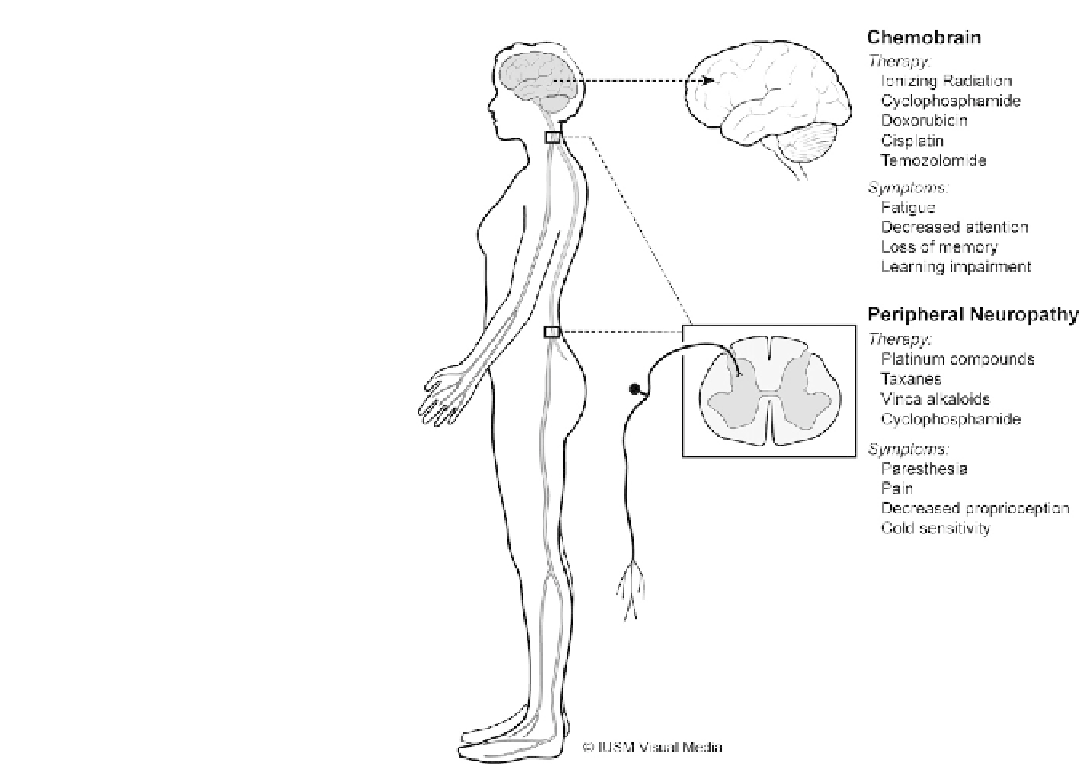Biology Reference
In-Depth Information
FIGURE 13.1
Representation of the two major
types of neurotoxicity produced by cancer therapy,
cognitive dysfunction, and peripheral neuropathy.
Courtesy of IUSM Visual Media.
diseases. For example, Weissman and co-workers
34
per-
formed postmortem examinations of the brains of
patients with Alzheimer's disease, patients with mild
cognitive impairment, and age-matched controls. They
found a significant reduction in BER repair pathway
activity in the brains of Alzheimer's and cognitive
impaired patients compared to controls. Similarly, post-
mortem levels and activity of apurinic/apyrimidinic
endonuclease (APE1), a critical enzyme in the BER path-
ways, were significantly reduced in the frontal cortex of
patients with ALS compared with controls.
35
In another
study, missense mutations of APE1 were observed in
patients with ALS suggesting that a loss of BER activity
might be involved in the pathogenesis of the disease.
36
Alterations in the BER pathway were also observed in
animal models of brain trauma
37
e
38
damage occurs in neurons despite the fact that these
cells are post-mitotic. This damage can be caused by
metabolism in cells, by exposure to oxidative stress asso-
ciated with injury,
23
by ionizing radiation,
6
by toxic
compounds found in the environment,
24
or by drugs,
including cancer chemotherapeutic agents.
1
Further-
more, DNA damage occurs with a number of neurode-
generative diseases including aging,
25
e
26
amyotrophic
lateral sclerosis (ALS),
27
Alzheimer's disease,
28
and Par-
kinson's disease.
29
In Alzheimer's disease an increase in
DNA oxidation in the brain may be one mechanism
responsible for the cognitive impairment observed in
patients.
30
e
31
Because extensive DNA damage can occur in neurons
and glial cells, it is not surprising that the major DNA
repair pathways are found in the central nervous system.
These repair pathways include base excision repair
(BER), nucleotide excision repair (NER), mismatch repair
(MMR), direct damage repair, and non-homologous end
joining (NHEJ) or homologous recombination (HR) path-
ways for double-strand break (DSB) repair.
13,32
e
33
A
number of studies show that alterations in these DNA
repair mechanisms occur
and ischemic
injury.
39
e
40
Hereditary neurological abnormalities in select
patient populations are linked to genetic defects in
DNA repair pathways. One such disorder, xeroderma
pigmentosum (XP), in which patients have a predisposi-
tion to develop cancer and neurodegeneration, is linked
to a defective NER pathway.
41
e
42
Neurological findings
in various neurological

